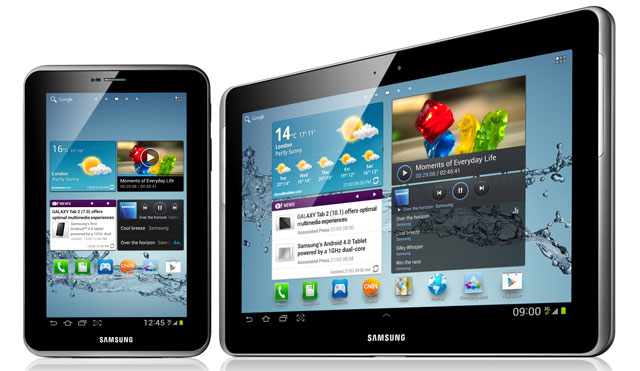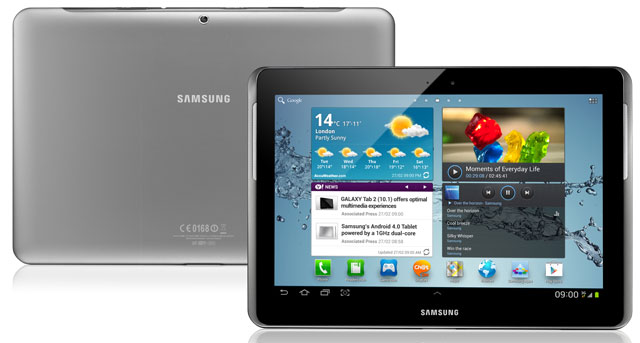
Samsung’s awkwardly named Galaxy Tab 2 10.1 is the Korean manufacturer’s follow-up to the hugely successful Galaxy Tab 10.1, the device that presented the first real competition to Apple’s market-leading iPad.
However, its follow-up not only fails to match Apple’s latest offering but only incrementally improves upon its predecessor.
We loved the first Samsung Galaxy Tab. It was everything an Android tablet should be — slim, potent, elegant and responsive — which led us to call it the best Android tablet to date, even if, at the time, the Android app ecosystem still trailed Apple’s.
Today, Android is a far more developed operating system and the range of applications is much more extensive. The Galaxy Tab 2 runs version 4.0 of Android, also called Ice Cream Sandwich. It’s far better suited to tablets than the Honeycomb version found on the first Galaxy Tab.
Strangely, Samsung hasn’t boosted the screen resolution from the first version of the Galaxy Tab. The resolution of the 10,1-inch display is still 1 280×800 pixels.
Although that’s respectable, we’d have liked to see a full HD display on the device, particularly in light of the 2 048×1 536 resolution of the new iPad, which, like it or not, is the device against which rival tablets will be measured.
A higher resolution would also be welcome in light of the Samsung’s wide-screen aspect ratio, a design decision that makes it better suited to video than the iPad. The two speakers on either side of the screen also suggest Samsung wants to position the Galaxy Tab 2 as a media consumption device, making the lack of improvement to the display all the more disappointing.
Though the display is unchanged, that tablet itself is very different from its predecessor. Gone are the minimalism and two-tone styling of the original Galaxy Tab in favour of the screen-hugging pair of speakers and a gun-metal grey plastic around the edges and rear with a darker shade of grey covering the panel at the top of the device that houses the SIM and microSD slots and the volume rocker and power button.
Frankly, the new model isn’t nearly as attractive as its predecessor. It does, however, offer a microSD slot for expansion (up to 32GB), something that was lacking the first time around and, for heavy media consumers, a great way to set the device apart from its closest rival.
The primary camera remains a 3-megapixel offering, while the front-facing camera is a similarly uninspiring 640×480-pixel model.
At 9,7mm deep and weighing in at 583g (two grams heavier than the Wi-Fi-only model) the Galaxy Tab 2 feels good in the hand and is no heavier than its main Android rivals and noticeably lighter than the 652g new iPad, even if it is 0,3mm thicker.
The front speakers may not be the most aesthetically pleasing, particularly when using the device in portrait orientation, but they’re definitely the best sounding speakers we’ve encountered on a tablet. They’re akin to the speaker quality of most laptop speakers — perfectly acceptable at low volumes, tinny at higher levels –an impressive feat considering how little space there is to work with on a tablet.

Annoyingly, Samsung has stuck to its proprietary 30-pin cable for charging and connecting the Galaxy Tab 2 to a laptop or desktop. We’d far rather see a regular, mini- or micro-USB cable, though Samsung claims the cable is necessary for speedy charging.
Battery life, as with the first Galaxy Tab, is excellent and users can expect in the region of 10 hours of heavy use. All of the usual forms of connectivity — HSPA+, the various Wi-Fi protocols and Bluetooth — are offered, along with DLNA support for streaming media to and from the device.
One of the most noticeable differences between the first generation Galaxy Tab and the second is the operating system. Ice Cream Sandwich is slick. Widgets, menus and icons look better, and Samsung’s minor tweaks are welcome. These include the ability to take a screenshot via an onscreen button next to the back, home and tasks buttons that are de rigeur in Android. Once you’ve taken a screenshot you can annotate the image or select a portion of it, either by cropping or dynamically selecting a portion of it with Samsung’s lasso-type tool.
Samsung has opted for a 1GHz dual-core processor and 1GB of RAM in the Galaxy Tab 2, which is respectable, but feels like a cut corner. The tablet handles most things thrown at it, but flicking between home screens produces minor lag, and opening lots of applications can introduce delays to home screen widgets’ updates.
Aside from the screenshot button, Samsung has also bolstered the toggles in the notification menu to include pretty much everything you could possibly want, from the standards like Wi-Fi and GPS to power saving and driving modes.
Gone is the horrible drag-to-the-edge-of-the-circle unlock method in favour of an approach where you swipe the lock screen anywhere you like. Users can of course also opt for an unlock pattern or password for added security and to prevent accidental unlocking.
Another pleasing addition is the arrow in the centre of the menu bar that brings up miniature applications that Samsung thinks users might want to access often. These include an alarm, calculator, e-mail, music player, Samsung’s own S Player, the task manager and a world clock. It’s a great feature and can be used within other apps.
To be expected, Gmail functionality is superb on the Galaxy Tab 2, as is integration with Google services generally. The built-in e-mail client is excellent, intuitive and works equally well in either orientation. The browser is similarly impressive, though arguably Google’s own Chrome browser application is even better. The tablet supports both Flash and HTML5, something some might consider an advantage over Apple’s iPad.
Samsung has also tried to encourage users to download content via the company’s own portal using its various “Hub” applications, another advantage over the iPad in the case of SA users who can’t download content from Apple’s iTunes Store.
All major video and audio formats are supported and the tablet includes an equaliser so that sound can be further tweaked to suit users’ preferences. On the whole, the Galaxy Tab 2 handles media with aplomb and offers attractive interfaces for its consumption, whether it’s audio, video, or photos and other images.
What the Samsung Galaxy Tab 2 lacks in hardware upgrades it makes up for in the quality of the user experience it offers. Ice Cream Sandwich demonstrates that Android, which arguably has long since surpassed Apple’s iOS operating system when it comes to features and functionality on handsets, might finally be doing so on tablets, too.
Early Android tablets looked like scaled-up Android phones and lacked the cohesion, consistency and ease-of-use of Apple’s iOS on the iPad. Using the Galaxy Tab 2 is a far more pleasurable and intuitive experience than using its predecessor and Samsung has really considered the device itself when adding its customisations to the software.
It’s not the most exciting second-generation tablet, but the Samsung Galaxy Tab 2 once again places the Korean electronics giant at the head of the Android table and positions it as the strongest rival to Apple in the computer tablet market. It’s not perfect, but it’s pretty darn good.
- Only the 32GB, 3G and Wi-Fi model is available in SA. Recommended retail price is R6 599




